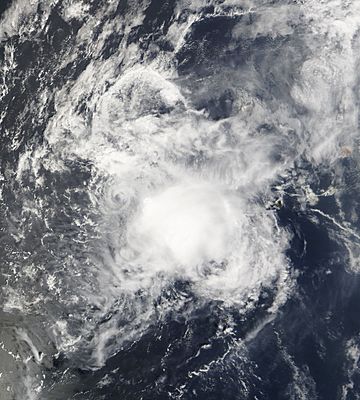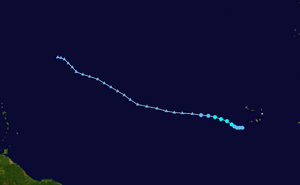Tropical Storm Melissa (2007) facts for kids
| Tropical storm (SSHWS/NWS) | |

Tropical Storm Melissa at peak intensity.
|
|
| Formed | September 28, 2007 |
|---|---|
| Dissipated | September 30, 2007 |
| Highest winds | 1-minute sustained: 40 mph (65 km/h) |
| Lowest pressure | 1005 mbar (hPa); 29.68 inHg |
| Damage | None |
| Areas affected | No land areas |
| Part of the 2007 Atlantic hurricane season | |
Tropical Storm Melissa was the 13th named storm during the 2007 Atlantic hurricane season. It was a short-lived storm that formed near the Cape Verde islands. Melissa stayed weak because of strong winds high up in the atmosphere, called wind shear. The storm faded away without causing any problems for land areas. Melissa was special because it was the eighth named storm to form in September 2007, which tied a record for that month.
Contents
How Tropical Storm Melissa Formed
The story of Melissa began on September 26. A "tropical wave" moved off the west coast of Africa. A tropical wave is like a ripple in the air that can help storms form.
On September 27, an area of low pressure started to form near Cape Verde. This low pressure area was linked to the tropical wave. Slowly, more and more thunderstorms, called convection, began to build up around this low pressure.
Becoming a Tropical Depression
By early morning on September 28, the thunderstorms grew quickly. The low pressure area became very organized. This allowed it to turn into Tropical Depression Fourteen. It was about 115 miles (185 km) west-southwest of the southern Cape Verde Islands.
At first, the depression moved very slowly. This was because the steering currents in the atmosphere were weak. Strong winds high up, known as wind shear, also made it hard for the storm to get stronger.
Melissa Becomes a Tropical Storm
On September 29, the storm began to get a little stronger. More thunderstorms formed. Tropical Depression Fourteen was then upgraded to Tropical Storm Melissa.
Just like other storms that year, such as Ingrid, Melissa had trouble getting stronger. This was due to high wind shear in the deep tropics. Wind shear can rip a storm apart.
For a short time on September 29, some weather experts thought Melissa had winds of 45 mph (75 km/h). But after looking at the storm more closely later, they found it was actually weaker. Its winds stayed at 40 mph (65 km/h).
When Melissa Faded Away
By the morning of September 30, the wind shear got much stronger. The ocean water also became cooler. These two things made Melissa start to weaken.
That morning, Melissa weakened back into a tropical depression. Its center became hard to find. It kept moving west-northwest a bit faster. The storm lost its deep thunderstorms. By the afternoon of September 30, Melissa turned into a "remnant low." This means it was just a leftover area of low pressure with no more thunderstorms.
Even after it was no longer a storm, the remnant low kept moving west-northwest. It finally disappeared completely on October 5. This happened northeast of the Leeward Islands.
Melissa's Impact and Records
Tropical Storm Melissa stayed far away from land during its whole life. It never threatened any land areas. No ships reported strong winds from Melissa. Because it stayed over the ocean, there was no damage or deaths reported.
When Tropical Depression Fourteen became Tropical Storm Melissa on September 29, it was the eighth named storm to form in the month of September that year. This was a big deal! It tied a record for the most named storms in September. The last time this happened was in the 2002 hurricane season.
Related pages
- 2007 Atlantic hurricane season
- NHC's archive on Tropical Storm Melissa


